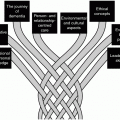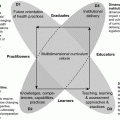- Interprofessional
The terms ‘interprofessional education/practice/teamwork’ etc. have been defined by various groups. These terms are often used interchangeably. Where we simply use the term ‘interprofessional’, we do so when two or more professions are working collaboratively together.
- Dementia
Dementia is now referred to as a neurocognitive disorder (NCD) (American Psychiatric Association, 2013), that is, the result of chronic or progressive damage to the brain.
Interprofessional capabilities
There are a number of models and interprofessional capability tools that have been developed internationally. Interestingly, the same capabilities (with different emphases according to the country and the environment in which they have been developed) seem to be included in some way in these tools:
- client-centred;
- collaborative working;
- reflection;
- cultural awareness;
- organisational competence;
- leadership skills;
- communication;
- role clarification;
- professionalism;
- conflict resolution;
- ethics and values.
- Capabilities
Forman, Jones & Thistlethwaite (2014) define capability as ‘has been used in preference to competence in one IPE framework, as it is considered by some educators to reflect more optimally the necessity that learners and professionals respond and adapt to health care and systems changes’.
Even though tools already exist to measure collaborative skills, we need to create an environment in aged care settings that will help to cultivate them. We, therefore, need to ensure that an organisation is ready to have these skills introduced, staff are supported in their development and an environment is created that will support staff in both sustaining and enhancing them.
Creating the right environment
While the leaders and key stakeholders within the organisation will need to initiate the need for change, a novel approach has been developed by the Wicking Dementia Research and Education Centre in conjunction with the University of Tasmania. This model introduces students as change agents along with stakeholder facilitators.
The model presented in Figure 7.1, developed through the Wicking Teaching Aged Care Facility Program, sets out the key stages used. The website (http://www.utas.edu.au/wicking) provides further information on this development and up-to-date resources on how to facilitate this change.

Figure 7.1 A model for interprofessional teaching in aged care facilities (Robinson et al., 2014) Reproduced with permission from Robinson et al. from the Wicking Dementia Research and Education Centre, University of Tasmania.
To ensure the sustained development of these skills, and thereby the continuity of effective teams, we need to ensure that the philosophy, policies and procedures are so embedded that these will exist, continue and develop even if there is a change of leadership. In research in this area, Micklan and Rodger (2005) undertook a study involving 202 health care professionals. Participants identified leadership as the most significant factor in maintaining interprofessional teamwork effectiveness. Sharing leadership functions was critical to the team’s performance. Equally, as Cerra and Brandt (2011) noted, as the practice context is becoming more diverse, this may require new skill sets for effective team functioning.
- Interprofessional teamwork
The levels of cooperation, coordination and collaboration characterising the relationships between professions in delivering patient-centred care.
Huxham and Vangen (2000) drew attention to the problem with all of the traditional leader/follower leadership models that incorporated a collaborative element. They noted the need for new leadership skills so that leaders can recognise the impact that these imposed processes and structures may have on themselves and their team, and learn to manage them, whilst devising tools to pursue, manage and shift an agenda forward. Leadership commitment is not only necessary from the top but from the team itself. For example, if one professional is absent in a multidisciplinary team, a key leadership role would be to ensure that resources are in place to provide the professional specific support required. In practice, this may require the leader to have political knowledge and strategies to fight for resources and lobby key players in economically tough times.
As Meads et al. (2009) stated, ‘incorporating aspects of leadership, team working and resilience will help interprofessional development to be more sustainable in the future.’
Janet McCray, Chichester University, UK
Meadow Leigh is a 35-bedded residential home for adults with dementia. The home had a regular and reliable team of staff. However, a quality inspection highlighted a home in which residents, although physically well cared for, were observed as being disengaged. There was institutional practice with routines based around staff need rather than individual requirements. At the same time as the inspection, several other changes took place. The manager and two other full-time staff members left and a local day care service closed.
A new manager has arrived and is intent on providing person-centred care, and building up activity and engagement for the residents in and out of the home, with input from an interprofessional team including physiotherapists, occupational therapists, social workers, nurse specialists, rehabilitation care assistants, and volunteer and family members of the community. The manager has introduced new hours of working and is role-modelling new practice with the person at the centre. Focus is on the introduction of new activities and engagement of the clients. The manager has announced that two full-time staff will be replaced by part-time staff, and that commissioned, sessional input from specialists will be developed and evaluated, depending on resident need.
The original team of staff are unhappy and confused, and are responding negatively to the new options and incoming new interprofessional team members. Many of the original team know residents’ family members and are expressing their views to them, creating tensions and distress, and suggesting residents will be unsettled.
Your role in the team
Person-centred practice consists of four key elements (Brooker, 2007):
Team-based care with the client at the centre holds five core principles (Mitchell et al., 2012):







